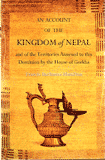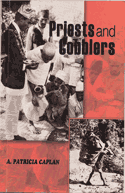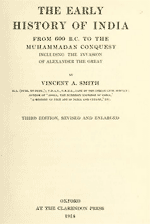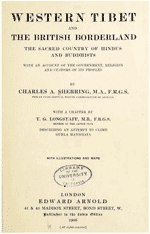
Francis Buchanan Hamilton, An Account of the Kingdom of Nepal and the Territories Annexed to this Dominion by the House of Gorkha (Edinburgh: Longman, 1819)
The book of Francis Buchanan Hamilton An Account of the Kingdom of Nepal is the second book in English ever written on Nepal’s history. The first is the 1811 book by Colonel William Kirkpatrick, which was worked on before 10 November 1793.
Hamilton spent fourteen months in the country, during 1802-1803, mostly in the vicinity of Kathmandu, as a low profile visitor of the British government. He spent another two years along Nepal’s tarai frontier. Apparently, the intention behind his mission was to report to the authority back home about his findings on the state and people of this Himalayan country. The book of Hamilton is the only account which discusses the entire country of Nepal and does not limit itself to the Kathmandu Valley or its vicinity.
As a foreign visitor, Hamilton “employed to obtain information, so far as [he] prudently could, without alarming a jealous government or giving offence to the Resident, under whose authority [he] was acting.” He had some support of Colonel Crawford, at that time surveyor-general in Bengal, with several drawings of Nepal and valuable geographical surveys and maps. The account of Nepal by Kirkpatrick which was already published by that time had provided him with certain definite background to proceed.
Hamilton worked with some Nepali and Indians to trace out the details about the tribes, the physical features of the country, laws and government and the various princely states that formed the unified Nepal. Trained as a physician, he seemed to be good in geography, zoology and botany as well. That helped him a lot in making his study visit a success.
Hamilton divided his book in two parts. Part I has two chapters. Chapter I deals with the inhabitants of Nepal. Here he deals with what he describes as Hindu colonists from ‘Chitaur’, ‘Asanti’ and ‘Chaturbhuja.’ Attempts have been made here to describe the Hindu tribes east of the Kali River here. There are descriptions on Brahmans, their diet, festivals and offspring. He has specific mentions about Rajputs, and adopted and illegitimate low tribes in the Hindu community. This follows his general observation on the customs of these mountain Hindus east of the Kali, and those west of it. Then he provides details about Magars, Gurungs, Jariyas, Newars, Murmis, Kirats, Limbus, Lapchas and Bhotiyas. The later group has been described by him as tribes who occupied the country previous to the arrival of Hindus. Chapter II is about the nature of the country, the plains, hills and mountains, their production, animal and vegetables, cultivation, climate, rivers, and so on. Chapter III devotes to laws and government of Nepal. There are orientations on courts and forms of proceeding, punishment, provincial government, revenue and endowments, state officers and military establishment. They all make the book interesting reading.
In Part – II, there are two chapters. Chapter I has four sections – each dealing with Sikkim, the dominions of the family descended from ‘Makanda Sen’, Raja of Makwanpur, and the history of Nepal Proper previous to the conquests by the ‘Gorkhalese’, and the countries belonging to the Chaubisi and Baisi Rajas. Chapter II deals with the countries west of the River Kali. The second part is a valuable record on distinct political units of Nepal including Sikkim, Sen Dominions, Nepal Proper, Baisi-Chaubisi and Kumaon-Garhbal-Barh Thakuri. There are notes on twelve petty chiefdoms in the western Himalayas. The book describes Nepal as it stood previously to the war with the British, commencing in the end of the year 1814. There are interesting information in Part – II as well.
The book of Hamilton stands out as the best of the early accounts of Nepal. Beginning the first part, the author describes Nepal, a name celebrated in Hindu legend, as the country in the vicinity of Kathmandu, but as it stands now it means the whole territory of the unified Nepal. East from the Nepal Proper, he notes, the mountains are chiefly occupied by Kirants, who are frequently mentioned in Hindu legend as occupying the country between Nepal and ‘Madra’, the ancient denomination now called ‘Bhotan.’ Towards the west again, according to Hamilton, “the country between Nepal and ‘Kasmir’, over which the present rulers of the former have far extended their dominion, in the ancient Hindu writings is called Khas, and its inhabitants Khasiyas. I am told, that, wherever mentioned in ancient records, like the Kirats, their neighbours to the west, the Khasiyas are considered as abominable and impure infidels.”
For any reader, this book is a window of knowledge about many important aspects of Nepal at that point of time. While the book is very useful, there are many factual errors, hearsay and misinterpretation. One significant example is his thinking that the Khas people are different from the mountain Hindus. They are the same lot in Nepal, but with different levels of reception of Hindu values. His reference that Hindus of mountains arrived there following invasion by the ‘Muhammedan’ king of ‘Dili’ is another mistake of fact. Hamilton noted that the king wished to marry a daughter of the Raja of ‘Chitor’ or ‘Chitaur’, celebrated for her beauty, and the offer was denied. There is simply no truth in the story. Maybe there are unknown exceptions, but most of the rulers he described as Hindu colonists from ‘Chitaur’, ‘Asanti’ and ‘Chaturbhuja’ have been indigenous rulers, and the story of their connections with these places have been willful fabrication for political benefits.
Similarly, Hamilton described the mountain Hindus as “deceitful and treacherous people, cruel and arrogant towards those in their power, and abjectly mean towards those from whom they expect favour.” This is too subjective a statement for anybody. He has a very low opinion about the Khas people for unstated reasons. He described them as “abominable and impure infidels” as noted above.
Many of these errors could be attributed to the informants who assisted Hamilton with information and helped him make judgments. But more than that Hamilton had a skeptical attitude about the rulers of Nepal, and those who assisted them to rule the country. The ‘Gorkhalese’ were victorious people, and were considered expansionist as well. As a jealous British official it was natural that his misgivings about the rulers and their associates had some effect in his writings as well.





